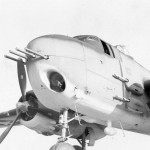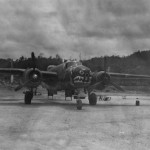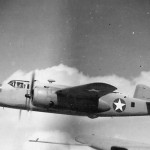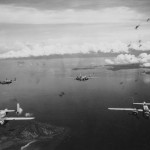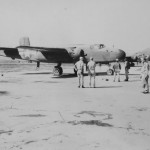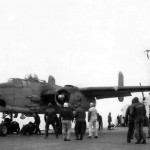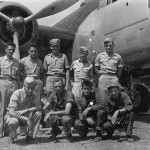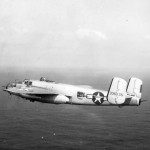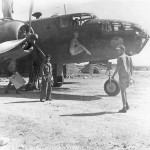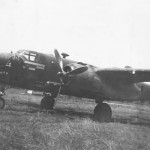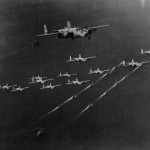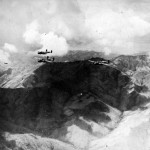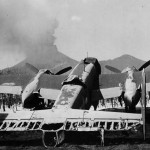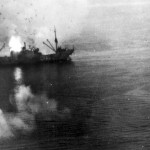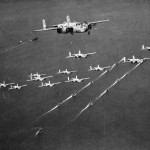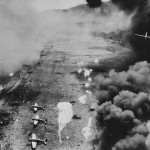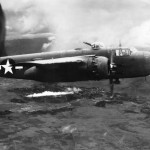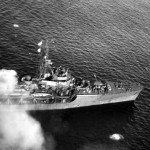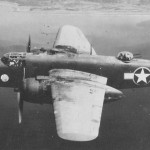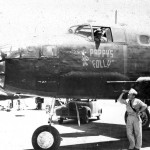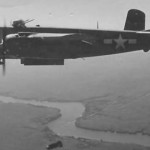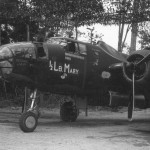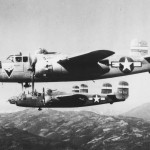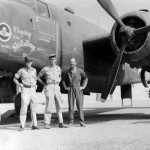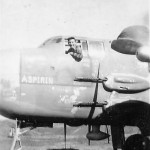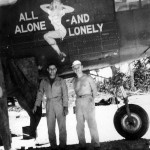Mitchell 41-30669 Tondelayo nose art
B-25 PTO
Mitchell with Mitch The Witch nose art
B-25 The Wac-a-teer
B-25H at Liangshan, China 1945
B-25J 44-30934 “Betty’s Dream”, Nose Art Bat Outa Hell Ie Shima 499th Bomb Squadron 345th BG 1945.
B-25 Mitchell Gunship Pacific
Damaged B-25 Mitchell Bomber
B-25 Mitchell Bomber and crew
B-25J 43-27636 “Ave Maria” of the 447th BS, 321st BG, Corsica. Pilot Capt W.E. Marchant
North American B-25 Mitchell “The Sad Sack”
North American B-25 Mitchell Parked On Pacific Airfield
B-25 Mitchell Bomber “Baby Blue Eyes”
North American B-25 Mitchell Gunship Skull Nose Art PTO
B-25J Mitchell Strafer “Nasty Nancy” nose art
North American B-25 Mitchell during test flight
B-25D “Lucky Bat” 41-30058 of 499th BS, 345th Bomb Group
P-38 and B-25 Mitchell Bomber
North American B-25 Mitchell PTO
Navy PBJ-1H Mitchell nose
B-25 New Guinea Bat Outa Hell Bombers On Way To Target 1944
B-25 Mitchell Parked On Pacific Airstrip
B-25 Mitchell Strafer Bats Outta Hell 345th BG
North American B-25C bomber 61 in flight during World War II
B-25 Mitchell wreck pacific
Mitchell 42-64853
B-25H Mitchell Gunship of the 38th BG 823rd BS PTO
North American B-25J Mitchell Alaska
P-51D Mustang of the 325th FG escorting a 12th AF B-25J 340 BG over Italy during 1945
PBJ Mitchell bombers in heavy AA fire over Rabaul 1944
B-25J Mitchell of the 77th BS Being Attacked by Japanese Fighter
Mitchell Eager Wolves 1944
RAF B-25 Mitchell Coming in For Landing 1944
B-25 Mitchell Bomber “The Vigorous Virgin” Nose Art
B-25 Mitchell of 345th Bomb Group Air Apaches Bats Outa Hell Nose Art
B-25 Mitchell bomber in flight over jungle during World War II
B-25 Mitchell bombers of the 12th BG formation, Tunisia 1943
North American B-25 Mitchell front view
North American B-25 Attack Bomber “Darlin” nose art
North American B-25D Mitchell Bomber of the 340 BG 488 BS, 8E
PBJ-1H ready for catapult launch from USS Shangri-La (CV-38), November 1944
B-25D 41-29737 “Twenty Or Nothing” of the 38th Bombardment Group
AT-24 advanced Trainer
B-25J Mitchell aircraft Alexai Point Attu 77th BS 1944
Crew Posed by Their B-25 Mitchell
B-25 Mitchell of 42nd Bomb Group low altitude raid on Balikpapan 1945
Mitchell in flight Attu Alaska, 77th BS 28th BG, 1944 43-36135
B-25 Mitchell Strafer Weezie of the 41st Bomb Group, 1945
B-25 Mitchell Shock Job Nose Art
B-25C Mitchell Bomber in North Africa
Mitchell of the 12th BG Earthquakers nose art
Mitchell 41-30164 “Doodle Jr.” and Pilots of Bats Outa Hell 499th BS, 345th BG
North American B-25 Attack Bomber Grass Cutter
B-25D Mitchell Bomber Nose Art Rosie
B-25J Mitchell Battlin Betty Nose Art
“Mortimer” 41-12443 of the 90th Bomb Squadron with shark mouth
B-25J Mitchell 340 BG 489 BS Taking Off From Airstrip
Mitchell “Fat Cat” Pacific Theater 1943
B-25 Mitchell of the 38th Bomb Group, 71st BS 1943 New Guinea
B-25 Mitchells Heading for Raid on Rabaul 1944
B-25 Mitchell of the 38th Bomb Group Hardships 2nd nose art
North American B-25D Mitchell Bomber 51
North American B-25 Mitchell medium bomber
Mitchell 41-30164 “Doodle Jr.” and Pilots of Bats Outa Hell 499th BS, 345th BG New Guinea
B-25D 41-30163 Butch of the 345th Bombardment Group, 501st Bombardment Squadron
B-25D Mitchell 41-30592 of the 345th BG, 500th Bombardment Squadron, Nose Art Mexican Spitfire
Aircrew Posed by Their B-25 Mitchell
B-25J 43-36198 “Pretty Pat” nose art, 345th Bomb Group. 499 BS
B-25C Mitchell 41-12464 “The Nip Clipper” of the 13th Bomb Squadron
North American B-25 Mitchell Attack Bomber
B-25D of the 340th BG, 486th BS MTO
North American B-25D Mitchell 41-30818
B-25H Mitchell of the 341st Bomb Group
B-25J Mitchell “1 For The Gipper” 42nd Bomb Group
B-25 6 Photo Group The Hawkeye Express nose art
11th Air Force B-25 skip bombing raid 1945 2
B-25 Mitchell Bomber SWEET ELOISE nose art
B-25D 41-30055 “Rita’s Wagon” 345th Bomb Group, 500th BS „Air Apaches” September 1944
B-25J Mitchell Gunships 345th Bomb Group “Air Apaches”
B-25 Bomber “SMOKO” nose art
B-25J Mitchell Gunship
B-25 bombers flying over Burma April 1944
Vesuvius and B-25C Mitchell of the 321st BG, 22 March 1944
11th Air Force B-25 skip bombing raid 1945
B-25 bombers and ships march 1944
North American B-25C-5 Mitchell bomber in flight 42-53387
B-25 attack bomber FRISKY FRISCO
B-25J Mitchell Gunship guns
1th Air Force B-25 skip bombing raid 1945 3
Cletrac M2 Tractor and PBJ Mitchell of the VMB-611
North American B-25 Mitchell
B-25 drop parafrags Dagua New Guinea February 1944
B-25 Mitchell of the 81st BS 12th BG over africa desert
5th Air Force B-25 Strafing Ki-43 Hayabusa Clark Field 1945
B-25 Mitchell bomber shark mouth 1944
341st Bomb Group B-25H Mitchell with 75mm gun Tengchung China 1944
North American B-25 in flight
B-25 Mitchell “Scat” 5th Air Force in Australia 1943
1th Air Force B-25 Skip Bombing Raid 1945 5
A-20 destroying japanese oil East Indies 1944
1th Air Force B-25 Skip Bombing Raid 1945 4
13th Air Force B-26 and B-25 42-53435 after collision New Caledonia SWPA 1943
B-25 Mitchell “Tug o war” nose art
B-25D 41-29727 “Runts Roost” of the 3rd Bombardment Group, 90th BS with shark mouth
Gunships of the 500th BS, 345th BG “Air Apaches”, Clark Field 1 June 1945
B-25 41-12905 of the 38th Bomb Group, 405th BS 1942. “Tokyo Sleeper” nose art
North American B-25 Mitchell bomber
Strafer “Pappy’s Folly” of the 3rd Bomb Group 41-12437
B-25H Mitchell with 75mm cannon for ground attack CBI
B-25H Gunship Mitchell of the 12th BG 13
B-25 Foggia Airfield Comp Italy
B-25 Gunship Bomber China 1944
B-25J 43-28012 “1 For The Gipper” of the 42nd Bomb Group
B-25 Mitchell of the 38th Bomb Group 1942 “1/2 lb Mary” nose art
North American B-25C-5 Mitchell bombers in flight formation 42-53400
B-25 Mitchell 6th Photo Group “The Hawkeye Express” nose art Philippines
B-25 of the 341 Bomb Group, “Texas Tornado II” nose art CBI
North American B-25 Mitchell bomber CBI
B-25’s Mitchell of the 447th BS 321st BG enroute to bomb Monte Cassino March 1944. Vesuvius volcano eruption in the background.
B-25J Gunship 43-36020 “Reina del Pacifico” of the 345th Bomb Group, 501st Bomb Squadron
North American B-25H-1 Mitchell of the 12th BG 82nd BS, 43-4208, Vikin’s Vicious Virgin Nose Art cannon CBI
B-25J Mitchell 12th AF over Italy
B-25 Gunship attack japanese convoy Kavieng New Ireland 1944
North American B-25D-10 Mitchell “Brooklyn Dodger” Nose Art 41-30336 New Guinea
B-25H Gunship Mitchell, 1st Air Commando Group, CBI 1944
B-25 bombers destroys german supply depot
Mitchell of the 310th BG, 42-28929 43-4015 12AF over Italy
B-25 Mitchell bomber “SMOKY” nose art
Mitchell of the 310th BG, 380th BS, 12AF, “Worth Fighting For”, 42-53451 over Italy
B-25 Mitchell of the 38th Bomb Group 1942 “Outlaw” nose art
B-25D 41-30183 “Lucky Star” of the 38th Bomb Group 1943
B-25 Mitchell of the 341 Bomb Group
B-25 Mitchell USS Hornet 1942
B-25 C Mitchell Bomber WHODUNIT THE 2ND
Mitchell of the 341 Bomb Group “Flagship Skull and Wings”, Karachi India
B-25 Gunship of the 341st Bomb Group with Sharks Mouth China 1944
Mitchell of the 488th BS 340th BG, 8B 43-3990 12AF over Italy
B-25 J Mitchell Gunship Bomber ASPIRIN
B-25J Mitchell of the 488th BS, 340th BG Foggia Airfield Comp Italy 1944
B-25J Sheridan of the 341st Bomb Group, 491st Squadron CBI
B-25 Mitchell assembly line
B-25 Mitchell Bomber SASSY SAL
B-25J Sheridan of the 341st Bomb Group, 491st Squadron
B-25 Mitchell All Alone And Lonely Nose Art
B-25 Mitchell of the 38th Bomb Group 1942 nose art
B-25 Mitchell of the of the 823rd BS, 38th BG Okinawa 1945
B-25 Mitchell #70 of the 341st Bomb Group and crew, CBI
Mitchell “Angel of Mercy” 43-35982 of the 310th BG, 381st BS, 12AF, Fano Airfield Italy 1945
North American B-25 Mitchell was an American twin engined medium bomber manufactured by North American Aviation. Production: 9984.
Variants and serials
NA-40 (X14221)
Twin-engined five-seat bomber to meet 1938 USAAC requirement for attack bomber. NA-40 was direct B-25 predecessor. Originally powered by two 1,100 hp (820 kW) Pratt & Whitney R-1830-56C3G radials. First flew on 29 January 1939 but proved to be underpowered and difficult to handle, aggravated by engine problems and tail buffet.
NA-40B
The NA-40B (also known as the NA-40-2) was a modification of the NA-40 prototype with two 1,600 hp (1,193 kW) Wright R-2600-A71-3 radials and and a few minor aerodynamic adjustments. First flew in revised form on 1 March 1939. Bomber was crash landed whilst being flown on a single engine.
B-25 (serials 40-2165 – 40-2188)
The design of the NA-62 was approverd in September, 1939 and the first B-25 flow on August 19, 1940. Initial production version of was powered by 1,350 hp (1,007 kW) R-2600-9 2000-9 14-cylinder radial engines each driving a Hamilton-Standard propeler, 12 ft. 7 in. (3.84 m) diameter. The first nine aircraft were built with constant dihedral angle but from the 10th aircraft off the production line the outer wings were re-rigged flat to give the characteristic “gull-wing” arrangement. The first 24 B-25s built were delivered to the USAAC in February 1941. 17th Bomb Group at McChord Field, Washington, was the first unit to go operational with Mitchells.
B-25A (serials 40-2189 – 40-2228)
Similar to the B-25 except that self-sealing fuel tanks in the forward section of the wings and armour (⅜ in /9,5 mm) for the crew were added. Engines were the same Wright R-2600-9 as fitted in the B-25. First version of the Mitchell modified to make it combat ready. The first of 40 B-25As made its maiden flight on February 25, 1941.
B-25B, Mitchell Mk I (serials 40-229 – 40-2348)
This model had a completely revised armament. The nose gun remained but the midship and tail guns were replaced by two Bendix electrically-operated turrets each with two .50 cal. (12.7 mm) machine-guns (Bendix A4 upper turret and an A5 lower turret). The lower turret was retractable and remotely controlled. Lower turret was often removed already in service. The former tail gun position became a prone observation post. B-25B took part in one of the most famous bombing raids of the Second World War. The operation, which was officially known as the Tokyo Raid, was more popularly referred to as the “Doolittle Raid” after its
leader, Lt Col Doolittle.
B-25C, Mitchell Mk II, (NA-82)
B-25C was little changed from the B-25B: autopilot, new powerplants R-2600-13s, de-icing and anti-icing equipment added, the navigator’s astrodome was added; nose armament was increased to two .50 in/ 12.7 mm machine guns, one fixed and one flexible. Range was
raised through the addition of a 152-gallon self-sealing fuel tank in each wing. Later production aircraft were revised further with a modified exhaust system, a cabin heater, provision for a fuel tank in the bomb bay and underwing bomb and torpedo racks. The B-25C model was the first mass-produced Mitchell version. B-25C was built in the Inglewood, California plant.
Serials:
C: 41-12434 – 41-13038
C-1: 41-13039 – 41-13296
C-5: 42-53332 – 42-53493
C-10: 42-32233 – 42-32382
C-15: 42-32383, 42-32389-42-32532
C-20: 42-64502 – 42-64701
C-25: 42-64702 – 42-64801
B-25D, Mitchell Mk II, (NA-87)
Identical to the B-25C, built in the Kansas City plant.
Serials:
D: 41-29648 – 41-29847
D-1: 41-29848 – 41-29947
D-5: 41-29947 – 41-30172
D-10: 41-30173 – 41-30352
D-15: 41-30353 – 41-30532
D-20: 41-30533 – 41-30847, 42-87113 – 42-87137
D-25: 42-87138 – 42- 87452
D-30: 42-87453 – 42-8761, 43-3280 – 43-3619
D-35: 43-3620 – 43-3869
XB-25E
B-25C (42-32281) “Flamin’ Maimie” fitted experimentally with heated surface anti-icing equipment to wings and tail surfaces
XB-25F (NA-94)
Another prototype with new electric anti-icing equipment (ex B-25C)
XB-25G (41-13296)
Modified B-25C in which the transparent nose was replaced to create a short nosed gunship carrying two fixed .50 in (12.7 mm) machine guns and a manually loaded 75 mm M4 cannon (21 rounds), then the largest weapon ever carried on an USAAF bomber (9 ft. 0 in. /2.9 m long and weighs ~900 lb/410 kg). Prototype first flown on October 22, 1942
B-25G
The production model featured increased armor and a greater fuel supply than the XB-25G. The crew is reduced to 5, comprising the pilot (who fires the nose armament and releases the bombs or torpedo), 2nd pilot, navigator, gunner (who mans the upper turret) and radio operator. B-25Gs were likewise field modified to include 2 more .50-caliber/ 12.7 mm guns in the nose plus 4 in blister packs on the fuselage.
Serials:
G-1: 42-32384 – 42-32388
G-5: 42-64802 – 42-65101
G-10: 42-65102 – 42-65201
F-10
45 brand new B-25D modified for photographic reconnaissance. All armament, armour and bombing equipment was removed. Three cameras was installed in the forward section of the bombardier’s nose compartment. This tri-metrogen arrangement consisted of 3x K-17 or T-5 6in/15cm cameras arranged to view directly down and at oblique angles via ‘bug-eye’ apertures on the left and right sides.
B-25H
An improved version of the B-25G. The forward firing-guns are increased to include 4 50 cal. machine-guns (400 rounds each) in the armoured nose and 2 pairs of .50 cal./12,7 mm pods, one pair on each side of the fuselage in line with the pilot’s cockpit (400 rounds each).
The T13E1 light weight cannon replaced the heavy M4 cannon 75 mm. The top turret is moved forward into the roof of the navigator’s compartment. Between the wings and tail are 2 new waist positions, each armed with one .50 cal/12.7 mm gun. The tail gun mount of the B- 25H and J models used a Bell M-7 mount for a pair of .50-caliber/12.7 mm M-2 machine guns.
Serials:
H-1: 43-4105 – 43-4404
H-5: 43-4405 – 43-4704
H-10: 43-4705 – 43-5104
NA-98X “Super Strafer”, serial 43-4406
B-25H Fitted with Pratt & Whitney R-2800- 51 engines, first flew on 31 March 1944. Top speed 340mph/547km/h. Plane had square type wing-tips with balanced, 12in/30cm longer ailerons and propeller spinners. Crash on 24 April 1944 by pilot error.
B-25J, Mitchell Mk III
A glazed nose of the B-25C type replaces the armoured nose and the nose armament is reduced to one fixed and one flexible .50 cal./12.7 mm machine-guns. Aft of the nose the armament remains the same as for the B-25H The crew is increased to six to include a bombardier. Some with solid eight-gun nose. The B-25J was the most produced variant of the Mitchell, topping out at 4318 bombers delivered by North American Aviation.
Serials:
J-1: 43-3870 – 43-4104, 43-27473 – 43-27792
J-5: 43-27793 – 43-28112
J-10: 43-28113 – 43-28222, 43-35946 – 43-36245
J-15: 44-28711 – 44-29110
J-20: 44-29111 – 44-29910
J-25: 44- 29911 – 44-30910
J-30: 44- 30911 – 44-31510, 44-86692 – 44-86891
J-35: 44-86892 – 44-86897, 45-8801 – 45-9242 (45-8900 – 45-9242 not allocated, production terminated)
VB-25J
Mitchells converted for use as staff and VIP transports
RB-25
Obsolete B-25’s, aircraft no longer considered suitable for its original mission.
Trainers
AT-24A/TB-25D – 60 trainer modification of B-25D
AT-24B/TB-25G – trainer modification of B-25G.
AT-24C/TB-25C – trainer modification of B-25C.
AT-24D/TB-25J – trainer modification of B-25J.
TB-25K – 117 ex B-25J, Hughes E1 fire-control radar trainer
TB-25L – 90 ex B-25J, Hayes pilot-trainer conversion from 1952
TB-25M – 40 ex TB-25L, trainers for the E-1 and E-5 radar fire control systems
TB-25N – 47 ex B-25J, Hayes navigator-trainer conversion.
PBJ-1C
(BuNo 34998-35047)
Similar to the B-25C for the U.S. Navy. Often fitted with airborne search radar AN/APS-2 or -3 and radio navigation system LORAN. Mostly used in the anti-submarine role. 50 delivered.
PBJ-1D
(BuNo 35048-35096; 35098-35193; 35196-35202)
Similar to the B-25D for the Navy and USMC, 152 delivered. Often fitted with airborne search radar and used in the anti-submarine role.
PBJ-1G
(BuNo 35097 ex 42-65031)
U.S. Navy and USMC designation for the B-25G. Trials only.
PBJ-1H
(BuNo 35250-35297; 88872-89071)
U.S. Navy and USMC designation for the B-25H, 248 delivered.
One specially strengthened and hooked PBJ-1H was used for catapult launch and arrested landing trials on the USS Shangri-la, but the Navy did not continue development.
PBJ-1J
(BuNo 35194-35195; 35203-35249; 35798-35920; 38980-39012; 64943-64992)
Navy designation for the B-25J-1 to J-35 with improvements in radio and other equipment. Beside the standard armament package, the USMC often fitted with 5 inch underwing rockets and search radar for the anti-shipping/anti-submarine role. The large Tiny Tim rocket-powered warhead saw use in 1945. 255 delivered.
RAF serials
Mitchell Mk I: FK161 – FK183
Mitchell Mk II: FL164 – FL218, FL671 – FL709, FL851 – FL874, FR141 – FR207, FR 208 – FR209, FR362 – FR384, FR 393 – FR397, FV900-FV939, FV940-FV999, FW100-FW280, HD302-HD345, KL133-KL161, MA956-MA957
Mitchell Mk III: HD346-HD400, KJ561-KJ800, KP308-KP328
RAAF serials
A47-1 – A47-50
Bibliography and sources
- Jerry Scutts: Marine Mitchells in World War Two
- Jerry Scutts: PBJ Mitchell Units of the Pacific War, Osprey Combat Aircraft 40
- Ernest R. McDowell: B-25 Mitchell in action – Squadron/Signal Publications 1034 Aircraft No. 34
- Rene J. Francillon – USAAF Medium Bomber Units ETO & MTO 1942-45, Osprey Aircam / Airwar 7
- Charles Mendenhall: Deadly Duo: The B-25 and B-26 in WW-II
- Lou Drendel, Don Greer: Walk Around 12 B-25 Mitchell, Squadron Signal 5512
- North American B-25 Mitchell, Famous Airplanes Of The World old series 58 (japanese)
- Roger A. Freeman: North American B-25 Mitchell U.S.A.A.F. 1941-1945, Camouflage and Markings No. 22
- Bert Kinzey: B-25 Mitchell in detail & scale vol. 60, Squadron/Signal Publications
- Jerry Scutts: North American B-25 Mitchell, Crowood Press
- Krzysztof Janowicz, Waldemar Pajdosz: North American B-25 Mitchell cz. 1 – 3 , AJ-Press Monografie Lotnicze 78,79,82 (polish)
- Pilot Training Manual for the B-25 Mitchell Bomber by US Army Air Force
- Steve Pace: B-25 Mitchell Units of the MTO, Osprey Combat Aircraft 32
- Frederick A. Johnsen: North American B-25 Mitchell – Warbird Tech Volume 12, Specialty Press
- Temporary Handbook of Erection and Maintenance Instructions for the B-25 H-1-NA Medium Bombardment Airplanes, North American Aviation Inc
- William Wolf: North American B-25 Mitchell The Ultimate Look – From Drawing Board to Flying Arsenal, Schiffer Military History Book
- Norm Avery, John W. Lambert: B-25 Mitchell The Magnificent Medium
- Alan C. Carey: Leatherneck Bombers: Marine Corps B-25/PBJ Mitchell Squadrons in World War II, Schiffer Military History Book
- Steve Pace: B-25 Mitchell, Warbird History Series
- Lou Drendel: B-25 Mitchell Illustrated
- Jerry Scutts: B-25 Mitchell at War
- David Doyle: B-25 Mitchell in Action – Squadron/Signal Publications Aircraft No. 221
- Kev Darling: North American B-25 Mitchell, Warpaint 73
- Marek Katarzynski: B-25J “Mitchell” in Combat Over Europe (MTO), Kagero SMI Library 06
- Phil H. Listemann: The North American B-25 in RAAF Service, Allied Wings No. 9
- Ernest R. McDowell: North American B.25A/J Mitchell in U.S.A.A.F. – U.S.M.C. – R.A.F. – Free French – N.E.I.F.F. – K.O.N. Marine & Foreign Service, Osprey Aircam Aviation
- Edwin Schnepf: The Killer Mitchells: The Dramatic True Story of the Allies’ Most Deadly World War Two Medium Bomber – Air Classics Special 3
- Dana Bell: Air Force Colors Volume 3, Pacific and Home Front 1942-47, Squadron/Signal Publications 6152
- Andre Zbigniewski: 345 BG Vol 1, Kagero Air Miniatures 32
- Ray Wagner: The North American B-25A to G Mitchell, Aircraft Profile Number 59
- North American: Company Profile 1928-1996, Aeroplane Company Profile



















